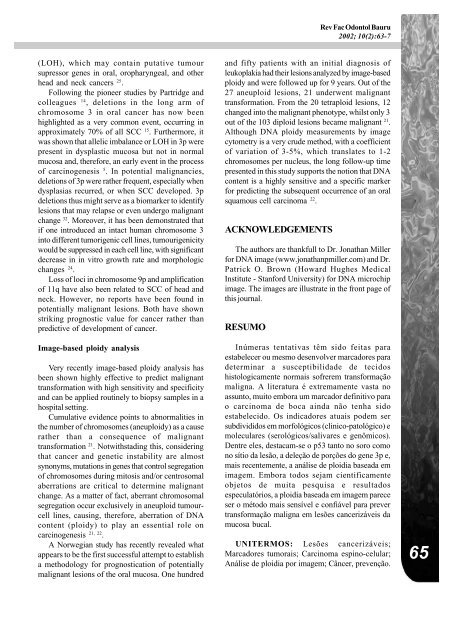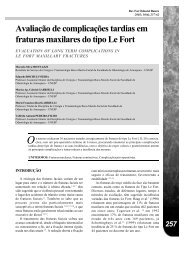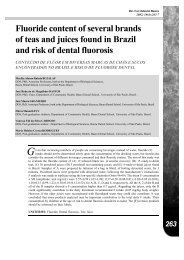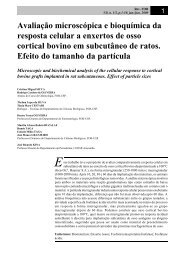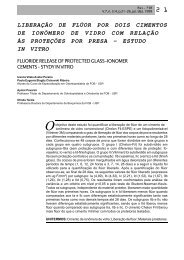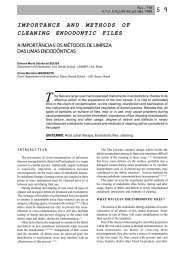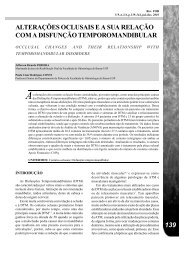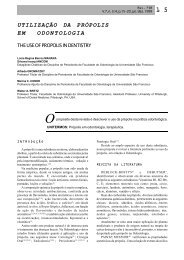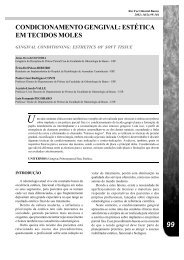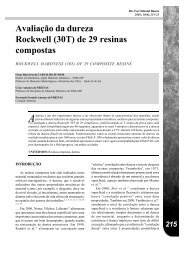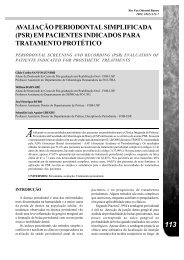biomarkers to predict oral squamous cell carcinoma in precancerous ...
biomarkers to predict oral squamous cell carcinoma in precancerous ...
biomarkers to predict oral squamous cell carcinoma in precancerous ...
Create successful ePaper yourself
Turn your PDF publications into a flip-book with our unique Google optimized e-Paper software.
Rev Fac Odon<strong>to</strong>l Bauru2002; 10(2):63-7(LOH), which may conta<strong>in</strong> putative tumoursupressor genes <strong>in</strong> <strong>oral</strong>, oropharyngeal, and otherhead and neck cancers 25 .Follow<strong>in</strong>g the pioneer studies by Partridge andcolleagues 14 , deletions <strong>in</strong> the long arm ofchromosome 3 <strong>in</strong> <strong>oral</strong> cancer has now beenhighlighted as a very common event, occurr<strong>in</strong>g <strong>in</strong>approximately 70% of all SCC 15 . Furthermore, itwas shown that allelic imbalance or LOH <strong>in</strong> 3p werepresent <strong>in</strong> dysplastic mucosa but not <strong>in</strong> normalmucosa and, therefore, an early event <strong>in</strong> the processof carc<strong>in</strong>ogenesis 5 . In potential malignancies,deletions of 3p were rather frequent, especially whendysplasias recurred, or when SCC developed. 3pdeletions thus might serve as a biomarker <strong>to</strong> identifylesions that may relapse or even undergo malignantchange 32 . Moreover, it has been demonstrated thatif one <strong>in</strong>troduced an <strong>in</strong>tact human chromosome 3<strong>in</strong><strong>to</strong> different tumorigenic <strong>cell</strong> l<strong>in</strong>es, tumourigenicitywould be suppressed <strong>in</strong> each <strong>cell</strong> l<strong>in</strong>e, with significantdecrease <strong>in</strong> <strong>in</strong> vitro growth rate and morphologicchanges 24 .Loss of loci <strong>in</strong> chromosome 9p and amplificationof 11q have also been related <strong>to</strong> SCC of head andneck. However, no reports have been found <strong>in</strong>potentially malignant lesions. Both have shownstrik<strong>in</strong>g prognostic value for cancer rather than<strong>predict</strong>ive of development of cancer.Image-based ploidy analysisVery recently image-based ploidy analysis hasbeen shown highly effective <strong>to</strong> <strong>predict</strong> malignanttransformation with high sensitivity and specificityand can be applied rout<strong>in</strong>ely <strong>to</strong> biopsy samples <strong>in</strong> ahospital sett<strong>in</strong>g.Cumulative evidence po<strong>in</strong>ts <strong>to</strong> abnormalities <strong>in</strong>the number of chromosomes (aneuploidy) as a causerather than a consequence of malignanttransformation 21 . Notwithstad<strong>in</strong>g this, consider<strong>in</strong>gthat cancer and genetic <strong>in</strong>stability are almostsynonyms, mutations <strong>in</strong> genes that control segregationof chromosomes dur<strong>in</strong>g mi<strong>to</strong>sis and/or centrosomalaberrations are critical <strong>to</strong> determ<strong>in</strong>e malignantchange. As a matter of fact, aberrant chromosomalsegregation occur exclusively <strong>in</strong> aneuploid tumour<strong>cell</strong>l<strong>in</strong>es, caus<strong>in</strong>g, therefore, aberration of DNAcontent (ploidy) <strong>to</strong> play an essential role oncarc<strong>in</strong>ogenesis 21, 22 .A Norwegian study has recently revealed whatappears <strong>to</strong> be the first successful attempt <strong>to</strong> establisha methodology for prognostication of potentiallymalignant lesions of the <strong>oral</strong> mucosa. One hundredand fifty patients with an <strong>in</strong>itial diagnosis ofleukoplakia had their lesions analyzed by image-basedploidy and were followed up for 9 years. Out of the27 aneuploid lesions, 21 underwent malignanttransformation. From the 20 tetraploid lesions, 12changed <strong>in</strong><strong>to</strong> the malignant phenotype, whilst only 3out of the 103 diploid lesions became malignant 21 .Although DNA ploidy measurements by imagecy<strong>to</strong>metry is a very crude method, with a coefficien<strong>to</strong>f variation of 3-5%, which translates <strong>to</strong> 1-2chromosomes per nucleus, the long follow-up timepresented <strong>in</strong> this study supports the notion that DNAcontent is a highly sensitive and a specific markerfor <strong>predict</strong><strong>in</strong>g the subsequent occurrence of an <strong>oral</strong><strong>squamous</strong> <strong>cell</strong> <strong>carc<strong>in</strong>oma</strong> 22 .ACKNOWLEDGEMENTSThe authors are thankfull <strong>to</strong> Dr. Jonathan Millerfor DNA image (www.jonathanpmiller.com) and Dr.Patrick O. Brown (Howard Hughes MedicalInstitute - Stanford University) for DNA microchipimage. The images are illustrate <strong>in</strong> the front page ofthis journal.RESUMOInúmeras tentativas têm sido feitas paraestabelecer ou mesmo desenvolver marcadores paradeterm<strong>in</strong>ar a susceptibilidade de tecidoshis<strong>to</strong>logicamente normais sofrerem transformaçãomaligna. A literatura é extremamente vasta noassun<strong>to</strong>, mui<strong>to</strong> embora um marcador def<strong>in</strong>itivo parao <strong>carc<strong>in</strong>oma</strong> de boca a<strong>in</strong>da não tenha sidoestabelecido. Os <strong>in</strong>dicadores atuais podem sersubdivididos em morfológicos (cl<strong>in</strong>ico-pa<strong>to</strong>lógico) emoleculares (serológicos/salivares e genômicos).Dentre eles, destacam-se o p53 tan<strong>to</strong> no soro comono sítio da lesão, a deleção de porções do gene 3p e,mais recentemente, a análise de ploidia baseada emimagem. Embora <strong>to</strong>dos sejam cientificamenteobje<strong>to</strong>s de muita pesquisa e resultadosespeculatórios, a ploidia baseada em imagem pareceser o mé<strong>to</strong>do mais sensível e confiável para prevertransformação maligna em lesões cancerizáveis damucosa bucal.UNITERMOS: Lesões cancerizáveis;Marcadores tumorais; Carc<strong>in</strong>oma esp<strong>in</strong>o-celular;Análise de ploidia por imagem; Câncer, prevenção.65


